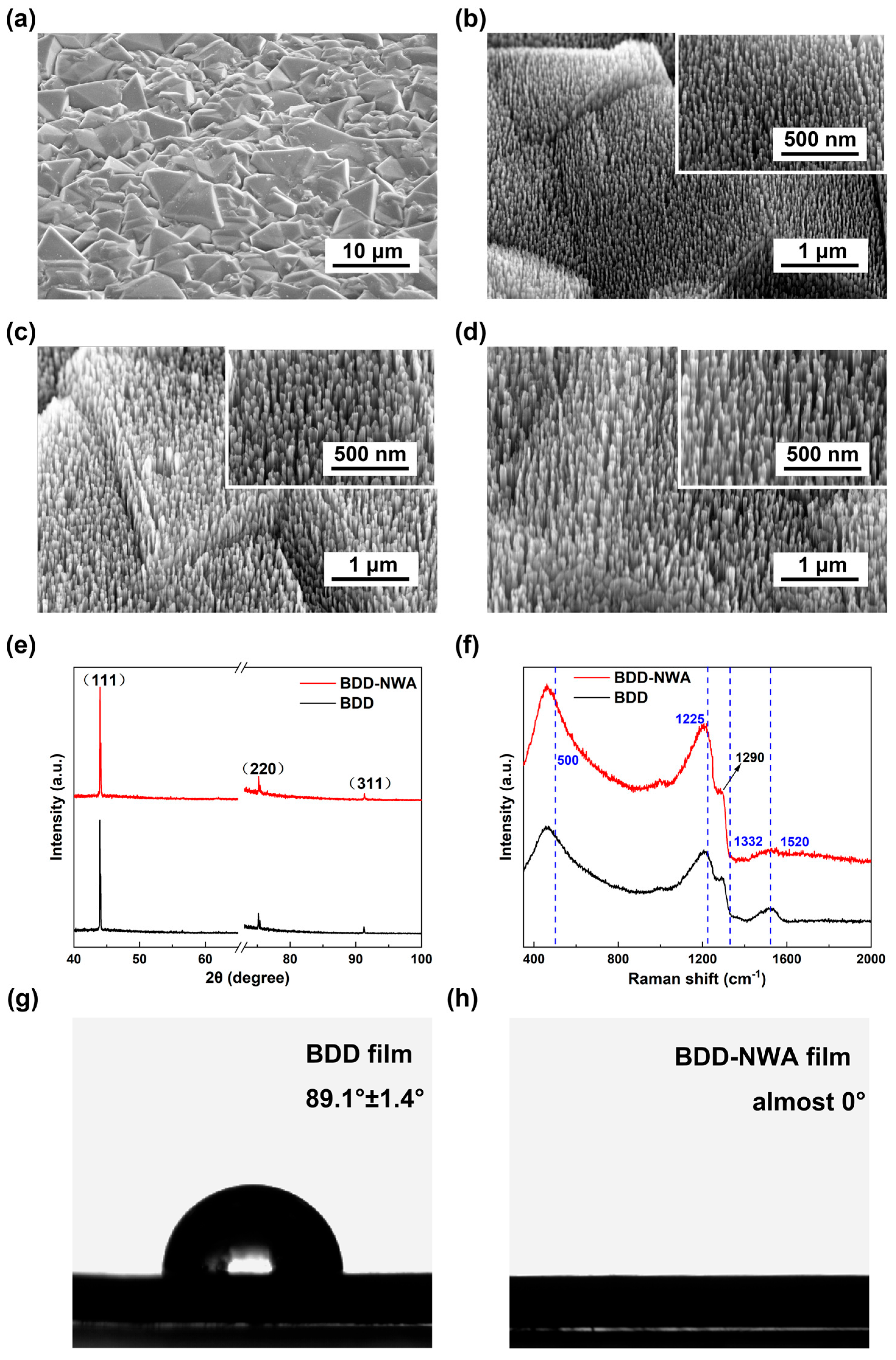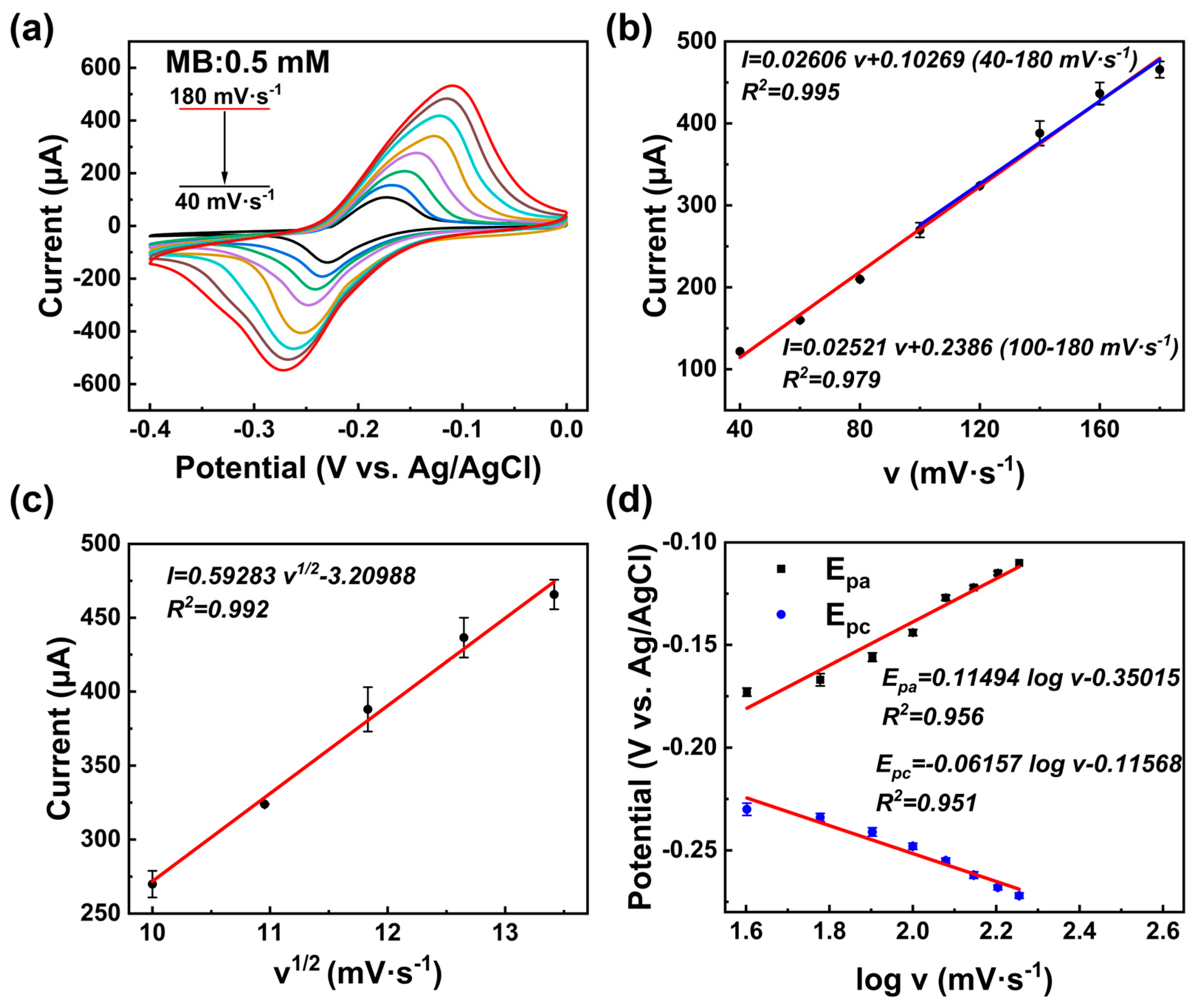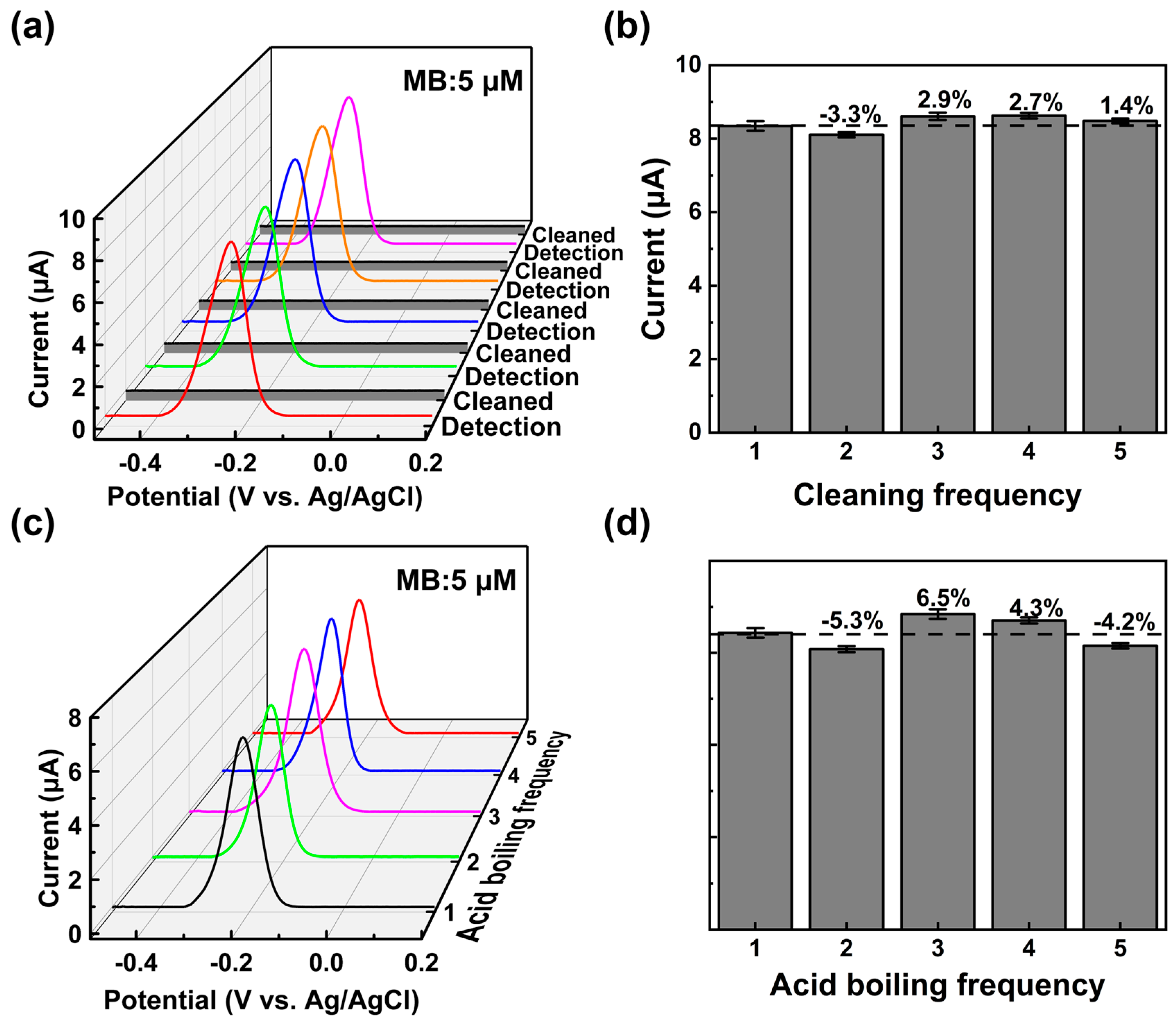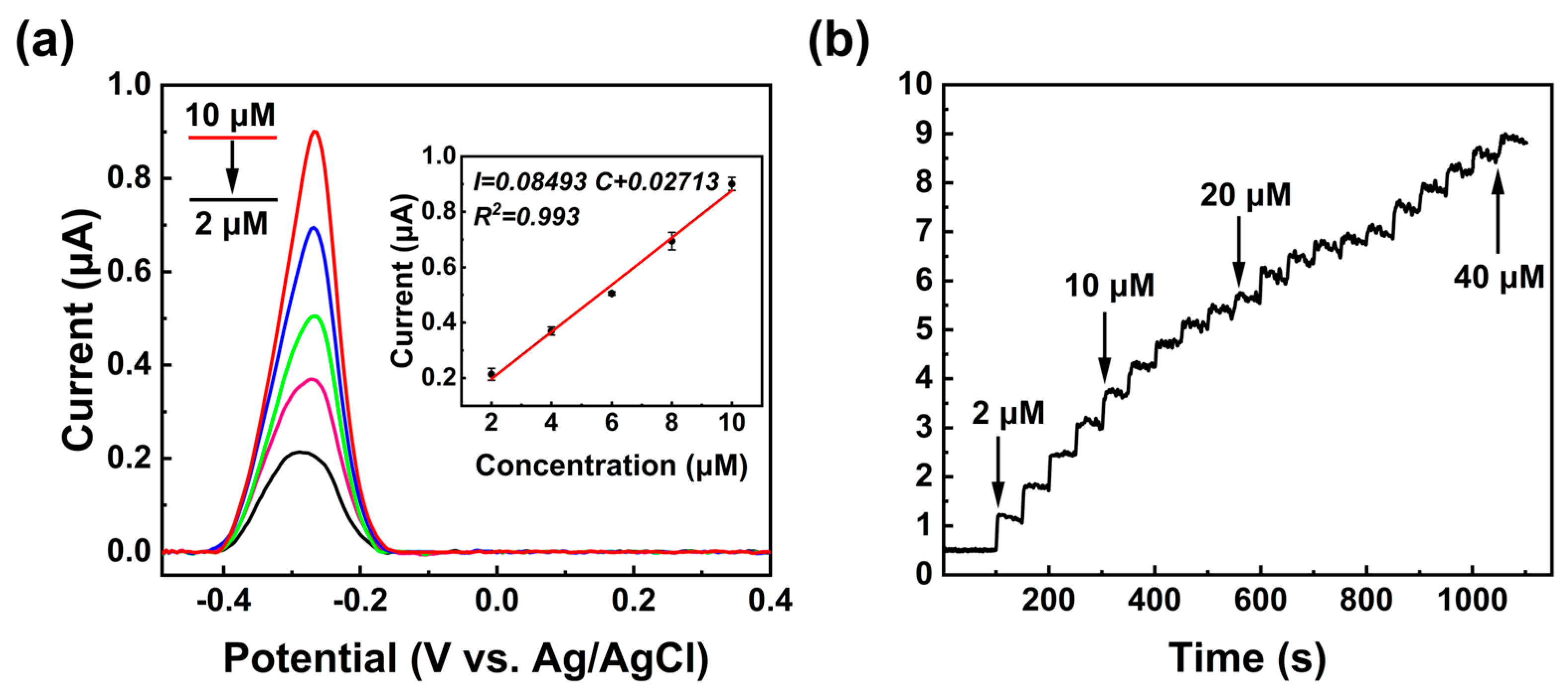Improving Trace Detection of Methylene Blue by Designing Nanowire Array on Boron-Doped Diamond as Electrochemical Electrode
Abstract
:1. Introduction
2. Experimental
2.1. Materials
2.2. Preparation of Electrodes
2.3. Characterization of Electrodes
2.4. Electrochemical Measurement
3. Results and Discussion
3.1. Characterization of BDD-NWA Electrode
3.2. Electrochemical Characterization of BDD-NWA Electrode
3.3. Detection of MB
4. Conclusions
Author Contributions
Funding
Institutional Review Board Statement
Informed Consent Statement
Data Availability Statement
Acknowledgments
Conflicts of Interest
References
- Hassan, S.S.; Sirajuddin; Solangi, A.R.; Agheem, M.H.; Junejo, Y.; Kalwar, N.H.; Tagar, Z.A. Ultra-fast catalytic reduction of dyes by ionic liquid recoverable and reusable mefenamic acid derived gold nanoparticles. J. Hazard. Mater. 2011, 190, 1030–1036. [Google Scholar] [CrossRef] [PubMed]
- Emmanuel, S.S.; Adesibikan, A.A. Bio-fabricated green silver nano-architecture for degradation of methylene blue water contaminant: A mini-review. Water Environ. Res. 2021, 93, 2873–2882. [Google Scholar] [CrossRef] [PubMed]
- Chen, W.S.; Chen, L.; Yang, S.S.; Chen, Z.Q.; Qian, G.N.; Zhang, S.X.; Jing, J.J. A novel technique for localization of small pulmonary nodules. Chest 2007, 131, 1526–1531. [Google Scholar] [CrossRef] [PubMed]
- Hamel, J. A Review of Acute Cyanide Poisoning with a Treatment Update. Crit. Care Nurse 2011, 31, 72–82. [Google Scholar] [CrossRef] [PubMed]
- Mathelin, C.; Croce, S.; Brasse, D.; Gairard, B.; Gharbi, M.; Andriamisandratsoa, N.; Bekaert, V.; Francis, Z.; Guyonnet, J.L.; Huss, D.; et al. Methylene Blue Dye, an Accurate Dye for Sentinel Lymph Node Identification in Early Breast Cancer. Anticancer Res. 2009, 29, 4119–4125. [Google Scholar] [PubMed]
- Peter, C.; Hongwan, D.; Küpfer, A.; Lauterburg, B.H. Pharmacokinetics and organ distribution of intravenous and oral methylene blue. Eur. J. Clin. Pharmacol. 2000, 56, 247–250. [Google Scholar] [CrossRef] [PubMed]
- Salhab, M.; Al Sarakbi, W.; Mokbel, K. Skin and fat necrosis of the breast following methylene blue dye injection for sentinel node biopsy in a patient with breast cancer. Int. Semin. Surg. Oncol. ISSO 2005, 2, 26. [Google Scholar] [CrossRef] [PubMed]
- Bai, S.W.; Huh, E.H.; Jung, D.J.; Park, J.H.; Rha, K.H.; Kim, S.K.; Park, K.H. Urinary tract injuries during pelvic surgery: Incidence rates and predisposing factors. Int. Urogynecol. J. 2006, 17, 360–364. [Google Scholar] [CrossRef] [PubMed]
- Lipskikh, O.I.; Korotkova, E.I.; Khristunova, Y.P.; Barek, J.; Kratochvil, B. Sensors for voltammetric determination of food azo dyes—A critical review. Electrochim. Acta. 2018, 260, 974–985. [Google Scholar] [CrossRef]
- Rengelshausen, J.; Burhenne, J.; Fröhlich, M.; Tayrouz, Y.; Singh, S.K.; Riedel, K.D.; Müller, O.; Hoppe-Tichy, T.; Haefeli, W.E.; Mikus, G.; et al. Pharmacokinetic interaction of chloroquine and methylene blue combination against malaria. Eur. J. Clin. Pharmacol. 2004, 60, 709–715. [Google Scholar] [CrossRef]
- Xu, J.Z.; Dai, L.; Wu, B.; Ding, T.; Zhu, J.J.; Lin, H.; Chen, H.L.; Shen, C.Y.; Jiang, Y. Determination of methylene blue residues in aquatic products by liquid chromatography-tandem mass spectrometry. J. Sep. Sci. 2009, 32, 4193–4199. [Google Scholar] [CrossRef] [PubMed]
- Nicolai, S.H.D.; Rodrigues, P.R.P.; Agostinho, S.M.L.; Rubim, J.C. Electrochemical and spectroelectrochemical (SERS) studies of the reduction of methylene blue on a silver electrode. J. Electroanal. Chem. 2002, 527, 103–111. [Google Scholar] [CrossRef]
- Razmara, R.S.; Daneshfar, A.; Sahrai, R. Determination of methylene blue and sunset yellow in wastewater and food samples using salting-out assisted liquid-liquid extraction. J. Ind. Eng. Chem. 2011, 17, 533–536. [Google Scholar] [CrossRef]
- Yuan, X.X.; Gao, N.; Gao, X.; Qiu, D.C.; Xu, R.; Sun, Z.L.; Jiang, Z.G.; Liu, J.S.; Li, H.D. Nanopyramid boron-doped diamond electrode realizing nanomolar detection limit of 4-nonylphenol. Sens. Actuator B-Chem. 2019, 281, 830–836. [Google Scholar] [CrossRef]
- Ma, Y.B.; Xu, X.Y.; Yang, T.Y.; Shen, Y.Y.; Jiang, F.; Zhang, Y.W.; Lv, X.T.; Liu, Y.M.; Feng, B.; Che, G.B.; et al. CO2 reduction synergistic tetracycline degradation toward Co-BiOBr ultrathin nanosheets with rich defects and (102) active faces. J. Alloy Compd. 2024, 970, 10. [Google Scholar] [CrossRef]
- Li, C.; Zhao, T.; Wei, Q.P.; Den, Z.J.; Long, H.Y.; Zheng, K.Z.; Li, H.C.; Guo, Y.H.; Yu, Z.M.; Ma, L.; et al. The effect of heat treatment time on the carbon-coated nickel nanoparticles modified boron-doped diamond composite electrode for non-enzymatic glucose sensing. J. Electroanal. Chem. 2019, 841, 148–157. [Google Scholar] [CrossRef]
- Yence, M.; Cetinkaya, A.; Ozcelikay, G.; Kaya, S.I.; Ozkan, S.A. Boron-Doped Diamond Electrodes: Recent Developments and Advances in View of Electrochemical Drug Sensors. Crit. Rev. Anal. Chem. 2022, 52, 1122–1138. [Google Scholar] [CrossRef] [PubMed]
- Luo, D.B.; Wu, L.Z.; Zhi, J.F. Fabrication of Boron-Doped Diamond Nanorod Forest Electrodes and Their Application in Nonenzymatic Amperometric Glucose Biosensing. ACS Nano. 2009, 3, 2121–2128. [Google Scholar] [CrossRef] [PubMed]
- Olejnik, A.; Ficek, M.; Szkodo, M.; Stanislawska, A.; Karczewski, J.; Ryl, J.; Dolega, A.; Siuzdak, K.; Bogdanowicz, R. Tailoring Diffusional Fields in Zwitterion/Dopamine Copolymer Electropolymerized at Carbon Nanowalls for Sensitive Recognition of Neurotransmitters. ACS Nano 2022, 16, 13183–13198. [Google Scholar] [CrossRef]
- Olejnik, A.; Ficek, M.; Siuzdak, K.; Bogdanowicz, R. Multi-pathway mechanism of polydopamine film formation at vertically aligned diamondised boron-doped carbon nanowalls. Electrochim. Acta 2022, 409, 12. [Google Scholar] [CrossRef]
- Boonkaew, S.; Dettlaff, A.; Sobaszek, M.; Bogdanowicz, R.; Jönsson-Niedziólka, M. Electrochemical determination of neurotransmitter serotonin using boron/nitrogen co-doped diamond-graphene nanowall-structured particles. J. Electroanal. Chem. 2022, 926, 12. [Google Scholar] [CrossRef]
- Niedzialkowski, P.; Cebula, Z.; Malinowska, N.; Bialobrzeska, W.; Sobaszek, M.; Ficek, M.; Bogdanowicz, R.; Anand, J.S.; Ossowski, T. Comparison of the paracetamol electrochemical determination using boron-doped diamond electrode and boron-doped carbon nanowalls. Biosens. Bioelectron. 2019, 126, 308–314. [Google Scholar] [CrossRef] [PubMed]
- Sain, S.; Ficek, M.; Olejnik, A.; Sawczak, M.; Bogdanowicz, R.; Roy, S.S. Direct determination of paraquat herbicide by square-wave voltammetry by two-step transfer mechanism at heterogeneous boron-doped carbon nanowall electrodes. Diam. Relat. Mat. 2023, 140, 12. [Google Scholar] [CrossRef]
- Hou, X.L.; Shen, G.J.; Meng, L.; Zhu, L.; Guo, M. Multi-walled carbon nanotubes modified glass carbon electrode and its electrocatalytic activity towards oxidation of paracetamol. Russ. J. Electrochem. 2011, 47, 1262–1267. [Google Scholar] [CrossRef]
- Ma, Y.B.; Liu, J.S.; Li, H.D. Diamond-based electrochemical aptasensor realizing a femtomolar detection limit of bisphenol A. Biosens. Bioelectron. 2017, 92, 21–25. [Google Scholar] [CrossRef] [PubMed]
- He, Y.P.; Dong, Y.J.; Huang, W.M.; Tang, X.Q.; Liu, H.H.; Lin, H.B.; Li, H.D. Investigation of boron-doped diamond on porous Ti for electrochemical oxidation of acetaminophen pharmaceutical drug. J. Electroanal. Chem. 2015, 759, 167–173. [Google Scholar] [CrossRef]
- Fujishima, A.; Rao, T.N. New directions in structuring and electrochemical applications of boron-doped diamond thin films. Diam. Relat. Mat. 2001, 10, 1799–1803. [Google Scholar] [CrossRef]
- Sousa, C.P.; Ribeiro, F.W.P.; Oliveira, T.; Salazar-Banda, G.R.; de Lima-Neto, P.; Morais, S.; Correia, A.N. Electroanalysis of Pharmaceuticals on Boron-Doped Diamond Electrodes: A Review. ChemElectroChem 2019, 6, 2350–2378. [Google Scholar] [CrossRef]
- Feng, Z.Y.; Gao, N.; Li, J.S.; Li, H.D. Boron-doped diamond electrochemical aptasensors for trace aflatoxin B 1 detection. Anal. Chim. Acta. 2020, 1122, 70–75. [Google Scholar] [CrossRef]
- Ma, Z.C.; Wang, Q.L.; Gao, N.; Li, H.D. Electrochemical detection of clenbuterol with gold-nanoparticles-modified porous boron-doped diamond electrode. Microchem. J. 2020, 157, 7. [Google Scholar] [CrossRef]
- Wang, P.; Yuan, X.X.; Cui, Z.; Xu, C.Y.; Sun, Z.L.; Li, J.H.; Liu, J.S.; Tian, Y.; Li, H.D. A Nanometer-Sized Graphite/Boron-Doped Diamond Electrochemical Sensor for Sensitive Detection of Acetaminophen. ACS Omega 2021, 6, 6326–6334. [Google Scholar] [CrossRef] [PubMed]
- Wan, L.; Liang, Y.; Yang, Y.; Zhang, Q.; Cui, Z.; Liu, J.; Cheng, S.; Gao, N.; Li, H.; Yuan, X. Electrochemical detection of phenacetin with graphite/boron-doped diamond electrode grown at high methane concentration. Diam. Relat. Mat. 2024, 144, 110965. [Google Scholar] [CrossRef]
- Feng, X.J.; Jiang, L. Design and creation of superwetting/antiwetting surfaces. Adv. Mater. 2006, 18, 3063–3078. [Google Scholar] [CrossRef]
- Zhu, Q.L.; Yang, Y.M.; Gao, H.X.; Xu, L.P.; Wang, S.T. Bioinspired superwettable electrodes towards electrochemical biosensing. Chem. Sci. 2022, 13, 5069–5084. [Google Scholar] [CrossRef] [PubMed]
- Wei, Q.Y.; Dong, Q.R.; Sun, D.W.; Pu, H.B. Synthesis of recyclable SERS platform based on MoS2@TiO2@Au heterojunction for photodegradation and identification of fungicides. Spectroc. Acta Pt. A Molec. Biomolec. Spectr. 2023, 285, 11. [Google Scholar] [CrossRef] [PubMed]
- Ma, Z.-C.; Gao, N.; Cheng, S.-H.; Liu, J.-S.; Yang, M.-C.; Wang, P.; Feng, Z.-Y.; Wang, Q.-L.; Li, H.-D. Wettability and Surface Energy of Hydrogen- and Oxygen-Terminated Diamond Films. Chin. Phys. Lett. 2020, 37, 046801. [Google Scholar] [CrossRef]
- Leem, J.W.; Yu, J.S. Broadband and wide-angle antireflection subwavelength structures of Si by inductively coupled plasma etching using dewetted nanopatterns of Au thin films as masks. Thin Solid Films 2011, 519, 3792–3797. [Google Scholar] [CrossRef]
- Brazhkin, V.V.; Ekimov, E.A.; Lyapin, A.G.; Popova, S.V.; Rakhmanina, A.V.; Stishov, S.M.; Lebedev, V.M.; Katayama, Y.; Kato, K. Lattice parameters and thermal expansion of superconducting boron-doped diamonds. Phys. Rev. B 2006, 74, 4. [Google Scholar] [CrossRef]
- Ashcheulov, P.; Sebera, J.; Kovalenko, A.; Petrák, V.; Fendrych, F.; Nesládek, M.; Taylor, A.; Zivcová, Z.V.; Frank, O.; Kavan, L.; et al. Conductivity of boron-doped polycrystalline diamond films: Influence of specific boron defects. Eur. Phys. J. B 2013, 86, 9. [Google Scholar] [CrossRef]
- Bernard, M.; Deneuville, A.; Muret, P. Non-destructive determination of the boron concentration of heavily doped metallic diamond thin films from Raman spectroscopy. Diam. Relat. Mat. 2004, 13, 282–286. [Google Scholar] [CrossRef]
- Wang, H.J.; Wang, Y.B.; Chai, X.; Guo, F.X.; Li, Y.L.; Shi, J.; Gai, Z.G.; Jiang, X. Influence of boron doped level on the electrochemical behavior and seawater salinity detection of boron doped diamond film electrodes. J. Electroanal. Chem. 2023, 931, 9. [Google Scholar] [CrossRef]
- May, P.W.; Ludlow, W.J.; Hannaway, M.; Heard, P.J.; Smith, J.A.; Rosser, K.N. Raman and conductivity studies of boron doped microcrystalline diamond, facetted nanocrystalline diamond and cauliflower diamond films. Chem. Phys. Lett. 2007, 446, 103–108. [Google Scholar] [CrossRef]
- Bernard, M.; Baron, C.; Deneuville, A. About the origin of the low wave number structures of the Raman spectra of heavily boron doped diamond films. Diam. Relat. Mat. 2004, 13, 896–899. [Google Scholar] [CrossRef]
- Yu, Z.M.; Wang, J.; Wei, Q.P.; Meng, L.C.; Hao, S.M.; Long, F. Preparation, characterization and electrochemical properties of boron-doped diamond films on Nb substrates. Trans. Nonferr. Met. Soc. China 2013, 23, 1334–1341. [Google Scholar] [CrossRef]
- Shirai, K.; Dekura, H.; Yanase, A. Utilization of high pressure for synthesizing superconducting semiconductors: Analysis of Ekimov’s method. Phys. Status Solidi B Basic Solid State Phys. 2009, 246, 673–678. [Google Scholar] [CrossRef]
- Gao, G.Y.; Fang, D.Y.; Yu, Y.; Wu, L.Z.; Wang, Y.; Zhi, J.F. A double-mediator based whole cell electrochemical biosensor for acute biotoxicity assessment of wastewater. Talanta. 2017, 167, 208–216. [Google Scholar] [CrossRef]
- Hayat, M.; Shah, A.; Nisar, J.; Shah, I.; Haleem, A.; Ashiq, M.N. A Novel Electrochemical Sensing Platform for the Sensitive Detection and Degradation Monitoring of Methylene Blue. Catalysts 2022, 12, 306. [Google Scholar] [CrossRef]
- Morsi, R.M.M.; Mandour, H.S.; Fathi, A.M.; Awad, H.M. Electrical properties, cyclic voltammetry, and anticancer activities of N-(4-(2-hydrazinyl-2-oxoethoxy)phenyl) acetamide complexes. J. Phys. Org. Chem. 2019, 32, 11. [Google Scholar] [CrossRef]
- Laviron, E. General expression of the linear potential sweep voltammogram in the case of diffusionless electrochemical systems. J. Electroanal. Chem. Interfacial Electrochem. 1979, 101, 19–28. [Google Scholar] [CrossRef]
- Belter, M.; Sajnóg, A.; Baralkiewicz, D. Over a century of detection and quantification capabilities in analytical chemistry—Historical overview and trends. Talanta 2014, 129, 606–616. [Google Scholar] [CrossRef]
- Prabhu, B.R.; Varier, M.M.; John, N.S. Fabrication of sandwich structures of Ag/analyte/MoO3 sea urchins for SERS detection of methylene blue dye molecules. Nanotechnology 2023, 34, 14. [Google Scholar]
- Patil, M.K.; Gaikwad, S.H.; Mukherjee, S.P. Phase- and Morphology-Controlled Synthesis of Tunable Plasmonic MoO3–x Nanomaterials for Ultrasensitive Surface-Enhanced Raman Spectroscopy Detection. J. Phys. Chem. C. 2020, 124, 21082–21093. [Google Scholar] [CrossRef]
- Li, C.; Wu, C.Q.; Zhang, K.; Chen, M.Q.; Wang, Y.S.; Shi, J.J.; Tang, Z.Y. The charge transfer effect on SERS in a gold-decorated surface defect anatase nanosheet/methylene blue (MB) system. New J. Chem. 2021, 45, 19775–19786. [Google Scholar] [CrossRef]
- Shaikh, I.; Sartale, S. Spin coated Ag NPs SERS substrate: Trace detection study of methylene blue and melamine. Appl. Phys. A—Mater. Sci. Process. 2023, 129, 12. [Google Scholar] [CrossRef]
- Atta, S.; Vo-Dinh, T. Bimetallic Gold Nanostars Having High Aspect Ratio Spikes for Sensitive Surface-Enhanced Raman Scattering Sensing. ACS Appl. Nano Mater. 2022, 9, 12562–12570. [Google Scholar] [CrossRef]
- Bélaz-David, N.; Decosterd, L.A.; Appenzeller, M.; Ruetsch, Y.A.; Chioléro, R.; Buclin, T.; Biollaz, J. Spectrophotometric determination of methylene blue in biological fluids after ion-pair extraction and evidence of its adsorption on plastic polymers. Eur. J. Pharm. Sci. 1997, 5, 335–345. [Google Scholar] [CrossRef]
- Li, J.; Zhao, F.; Zhao, J.; Zeng, B. Adsorptive and stripping behavior of methylene blue at gold electrodes in the presence of cationic gemini surfactants. Electrochim. Acta 2005, 51, 297–303. [Google Scholar] [CrossRef]
- Soto, P.C.; Salamanca-Neto, C.A.R.; Moraes, J.T.; Sartori, E.R.; Bessegato, G.G.; Lopes, F.; Almeida, L.C. A novel sensing platform based on self-doped TiO2 nanotubes for methylene blue dye electrochemical monitoring during its electro-Fenton degradation. J. Solid State Electrochem. 2020, 24, 1951–1959. [Google Scholar] [CrossRef]
- Tonlé, I.K.; Ngameni, E.; Tcheumi, H.L.; Tchiéda, V.; Carteret, C.; Walcarius, A. Sorption of methylene blue on an organoclay bearing thiol groups and application to electrochemical sensing of the dye. Talanta 2008, 74, 489–497. [Google Scholar] [CrossRef]
- Hassan, S.S.; Nafady, A.; Sirajuddin; Solangi, A.R.; Kalhoro, M.S.; Abro, M.I.; Sherazi, S.T.H. Ultra-trace level electrochemical sensor for methylene blue dye based on nafion stabilized ibuprofen derived gold nanoparticles. Sens. Actuator B-Chem. 2015, 208, 320–326. [Google Scholar] [CrossRef]








| Electrode Modifiers | Technique | Linear Range (μM) | Detection Limit (nM) | References |
|---|---|---|---|---|
| - | SERS | - | 100 | [51] |
| - | SERS | - | 10 | [52] |
| - | SERS | - | 10 | [53] |
| - | SERS | - | 0.1 | [54] |
| - | SERS | 0.00005–0.03 | 0.042 | [55] |
| - | UV-vis | 0.38–28.5 | - | [56] |
| - | UV-vis | 0.63–21.9 | 190 | [13] |
| Au | CV | 0.2–10 | - | [57] |
| Self-doped TiO2 nanotubes | CV | 1.0–7.94 | 475 | [58] |
| Thiol-functionalized clay | CV | 1.0–14 | 400 | [59] |
| Ibu-AuNPs | DPV | 0.01–1.1 | 3.9 | [60] |
| NH2-fMWCNTs | SWV | 0.01–0.5 | 0.21 | [47] |
| BDD-NWA | SWV | 0.04–10 | 0.72 | This study |
| Added (μM) | Found (μM) | Recovery (%) | RSD (%) |
|---|---|---|---|
| 0 | ND | - | - |
| 2 | 2.15 | 107.5 | 2.1 |
| 4 | 4.03 | 100.8 | 1.5 |
| 6 | 5.63 | 93.8 | 0.6 |
| 8 | 7.86 | 98.3 | 3.1 |
| 10 | 10.28 | 102.8 | 2.4 |
Disclaimer/Publisher’s Note: The statements, opinions and data contained in all publications are solely those of the individual author(s) and contributor(s) and not of MDPI and/or the editor(s). MDPI and/or the editor(s) disclaim responsibility for any injury to people or property resulting from any ideas, methods, instructions or products referred to in the content. |
© 2024 by the authors. Licensee MDPI, Basel, Switzerland. This article is an open access article distributed under the terms and conditions of the Creative Commons Attribution (CC BY) license (https://creativecommons.org/licenses/by/4.0/).
Share and Cite
He, S.; Lin, K.; Cheng, S.; Gao, N.; Liu, J.; Li, H. Improving Trace Detection of Methylene Blue by Designing Nanowire Array on Boron-Doped Diamond as Electrochemical Electrode. Coatings 2024, 14, 762. https://doi.org/10.3390/coatings14060762
He S, Lin K, Cheng S, Gao N, Liu J, Li H. Improving Trace Detection of Methylene Blue by Designing Nanowire Array on Boron-Doped Diamond as Electrochemical Electrode. Coatings. 2024; 14(6):762. https://doi.org/10.3390/coatings14060762
Chicago/Turabian StyleHe, Sihan, Kun Lin, Shaoheng Cheng, Nan Gao, Junsong Liu, and Hongdong Li. 2024. "Improving Trace Detection of Methylene Blue by Designing Nanowire Array on Boron-Doped Diamond as Electrochemical Electrode" Coatings 14, no. 6: 762. https://doi.org/10.3390/coatings14060762








